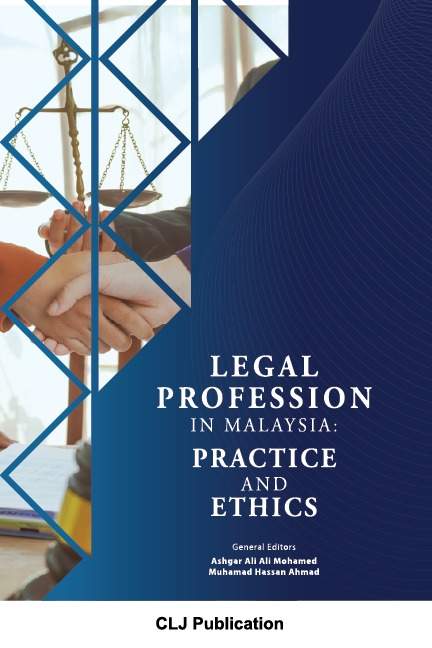Description
Legal Profession in Malaysia: Practice and Ethics is an essential guide for law students, academics, and practitioners seeking a deep understanding of both the Conventional and Syariah legal systems. Covering 31 insightful chapters, this book explores the evolution of Malaysia’s legal profession, the regulatory frameworks governing it, and the pathways to becoming an advocate, solicitor, or Syarie lawyer.
It delves into key ethical responsibilities, solicitor-client relationships, legal privilege, conflicts of interest, and professional misconduct, offering practical guidance for navigating legal practice with integrity. Addressing contemporary challenges such as globalisation, technological advancements, declining educational standards, and the growing need for specialisation, this book provides a thought-provoking analysis of the profession’s future.
Written by experts, it is an invaluable resource for those looking to master the complexities of legal practice in Malaysia.
CONTENTS
Preface
Foreword
Contributors
Table Of Cases
Table Of Legislation
Chapter 1: MALAYSIAN LEGAL SYSTEMS AND ADVERSARIAL TRIAL
1.1 Introduction
1.2 Islamic Law Before The Foreign Occupation Of Malay Peninsula
1.3 British Administration Of Malaya And Borneo States:
The Adoption Of Common Law System
1.3.1 Straits Settlements
1.3.2 Malay States
1.3.3 Borneo States
1.4 Common Law System And Islamic Legal System
1.4.1 Common Law System
1.4.2 Islamic Legal System
1.5 Adversarial And Inquisitorial Systems
1.6 Adversarial Trial And Legal Representation
1.6.1 Criminal Investigation And Trial
1.6.2 Civil Litigation Process
1.7 Legal Representation In Civil And Criminal Trial
1.8 Conclusion
Chapter 2: ACCESS TO JUSTICE: WITH REFERENCE TO INTERNATIONAL AND DOMESTIC LAW
2.1 Introduction
2.2 Access To Justice: An Overview
2.3 Access To Justice: The UN And Other International Instruments
2.4 Access To Justice: The Malaysian Perspective
2.5 Conclusion
Chapter 3: LEGAL PROFESSION IN MALAYSIA: THE HISTORY
3.1 Introduction
3.2 Legal Profession In Malaysia : The Origins
3.3 The Case Of Thomas Kekewich Of Penang
3.4 Early Notable Legal Practitioners And Their Legacy
3.5 The Legal Profession Post Second World War
3.6 Origins Of The Bar
3.7 Advocates And Solicitors Ordinance 1947
3.8 A Closed Bar
3.9 The Position In Sabah And Sarawak
3.10 Legal Education Qualifications
3.11 Conclusion
Chapter 4: LEGAL PROFESSION REGULATORY BODIES: CIVIL AND SYARIAH
4.1 Introduction
4.2 Legal Profession Qualifying Board
4.3 The Malaysian Bar
4.4 The Bar Council
4.5 State Bar Committee
4.6 Disciplinary Board And Disciplinary Committee
4.7 Syarie Legal Profession Qualifying Board
4.8 Badan Peguam Syarie
4.9 Majlis Peguam Syarie
4.10 Disciplinary Authority Of Majlis Peguam Syarie
4.11 Conclusion
Chapter 5: ADVOCATE AND SOLICITOR IN WEST MALAYSIA: THE ADMISSION REQUIREMENTS AND PROCESS
5.1 Introduction
5.2 Bachelor Of Laws : Recognition
5.3 Age And Personal Qualities
5.4 Bahasa Malaysia Requirement
5.5 Pupillage
5.6 Admission Petition : The Procedure
5.7 Master And Pupil Relationship
5.8 Articled Clerk
5.9 Admission Of An Articled Clerk As An Advocate And Solicitor : The Procedure
5.10 Admission With Special Certificates From Attorney General
5.11 Admission Of Foreign Lawyer
5.12 Liberalisation Of Legal Services : Foreign Law Firms And Foreign Lawyers In West Malaysia
5.13 Conclusion 148
Chapter 6: ADVOCATES IN EAST MALAYSIA : THE ADMISSION REQUIREMENTS AND PROCESS
6.1 Introduction
6.2 Advocate In Sarawak : The Admission Requirements 1And Procedure
6.2.1 The Qualifications For Admission
6.2.2 Pupillage : Exemption Or Shortening The Period
6.2.3 Advocate’s Admission : The Procedures
6.2.4 Admission As An Advocate
6.2.5 Advocate’s Exclusive Right To Practise In Sarawak
6.2.6 Temporary Licence And Ad Hoc Admission
6.3 Advocate In Sabah : The Admission Requirements And Procedure
6.3.1 The Qualifications For Admission
6.3.2 Pupillage
6.3.3 Waiver Or Exemption Of Pupillage
6.3.4 Admission Of Advocate
6.3.5 Advocate’s Exclusive Right To Practise In Sabah
6.3.6 Permission To Practise In Special Cases
6.4 Conclusion
Chapter 7: SYARIE LAWYER IN FEDERAL TERRITORIES : THE ADMISSION REQUIREMENTS AND PROCESS
7.1 Introduction
7.2 Peguam Syarie: Admission Requirements
7.3 Peguam Syarie: The Admission Procedure
7.4 Non – Muslim As Syarie Lawyer
7.5 Application For Admission As Advocate And Solicitor And Peguam Syarie : Whether Can Be Concurrent ?
7.6 Conclusion
Chapter 8: LAWYERS’ DUTIES TO PRESERVE AND PROTECT THE PROFESSION
8.1 Introduction
8.2 Improving The Standards Of Conduct And Promoting The Interests Of The Legal Profession
8.3 Public Interest In An Ethical Legal Profession
8.4 Conclusion
Chapter 9: LAWYERS’ INDEPENDENCE, HONESTY AND INTEGRITY
9.1 Introduction
9.2 Historical Context
9.2.1 Development Of Legal Ethics
9.2.2 Pre-Independence
9.2.2.1 Pre-Colonial Period
9.2.2.2 Colonial Era
9.2.3 Post – Independence Developments
9.2.4 Modern Era
9.2.4.1 Anti-Corruption Efforts
9.2.4.2 Ethics Initiatives
9.2.4.3 Changes In The Legal Framework
9.2.4.3.1 Legal Profession Act 1976
9.2.4.3.2 Malaysian Anti-Corruption Commission ( MACC ) Act 2009
9.3 Independence Of Lawyers
9.3.1 Definition Of Independence For Lawyers
9.3.2 Importance Of Independence
9.3.2.1 Upholding Justice
9.3.2.2 Client Trust
9.3.2.3 Professional Integrity
9.3.2.4 Public Confidence
9.3.2.5 Protection Of Rights
9.4 Conclusion
9.5 Honesty In The Legal Professions
9.5.1 Definition Of Honesty In The Legal Profession
9.5.2 Role Of Honesty In The Legal Profession
9.5.2.1 Duty To Client
9.5.2.2 Ethical Standards


Reviews
There are no reviews yet.